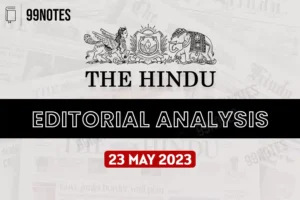25 May 2023 : The Hindu Editorial
The Hindu Editorial
25-May-2023
Daily Current Affairs For UPSC ,The Hindu Editorial Summary
1. Industrial investments: The Kerala story
Topic: GS3 – Indian economy.
Context:
-
-
-
Kerala’s industrial sector is overcoming its reputation as a hostile investment destination, attracting investments and showing growth in factories and fixed capital.
-
Kerala’s incremental success highlights the importance of a human development-based growth strategy.
-
-
Issue:
-
-
-
Kerala, known for its social development, is now attracting investments in the industrial sector, indicating a shift towards late industrialization.
-
The state has shown modest growth in industrial factories (2.55% CAGR) compared to the national average (4.07%) but outperformed states like Maharashtra and Tamil Nadu.
-
Kerala’s factory fixed capital investment grew significantly (12.82% CAGR) compared to the national average (7.33%) and other states like Tamil Nadu and Karnataka.
-
Sustaining investment flows, striking a balance between traditional and modern industries, and managing physical infrastructure expansion are the significant challenges for further industrialization.
-
Kerala needs differentiated approaches to attract investments, considering the common strategies adopted by other states and the Centre’s initiatives.
-
Balancing employment generation, preserving traditional industries, and exploring modern industries for higher value addition are crucial.
-
Kerala must carefully plan infrastructure development, considering environmental constraints, fiscal limitations, and the possibility of natural calamities.
-
Policy continuity and stability have played a role in attracting investments, and a human development-based growth strategy has been effective in incremental investment attraction.
-
-
2. A word of caution about India and the AI wagon
Topic: GS3 – Science and technology.
Context:
-
-
-
Technology leaders, researchers, and experts express rising concerns about the dangers of Artificial Intelligence (AI).
-
-
Issue:
Potential challenges for deployment of AI Systems in India:
-
-
-
Biases and Discrimination: The immediate threat of AI lies in reinforcing biases, de-emphasizing representation, and trivializing diversity, which can lead to further exclusion and inequity for marginalized groups.
-
Algorithms and AI systems have exhibited biases in credit scoring and healthcare diagnostics, perpetuating discrimination against certain groups.
-
Need to take ethical considerations: India is increasingly adopting AI for targeting, efficiency, and social welfare. Still, there is a need for more discussion on the data used to train these algorithms and the ethical considerations involved.
-
Lacks moral compass and Empathy: AI relies on Big Data or programmatic rules to learn and replicate human intelligence, communication, and actions but lacks a moral compass and empathy.
-
Algorithms can perpetuate past biases and generalize them to the population, leading to discriminatory outcomes.
-
India faces challenges of poor administrative data, low awareness of algorithms, and excessive dependence on algorithm outputs.
-
AI deployment in India should be based on clean, organized, well-governed public data and developed responsibly and inclusively.
-
Collaboration between the private sector, practitioners, and the government is essential to ensure AI reflects the country’s diversity and supports progress towards equality and equity.
-
-
Potential advantages of AI for India:
-
-
-
Enhanced efficiency and productivity: AI can automate repetitive tasks, streamline processes, and improve efficiency in various sectors, leading to increased productivity and economic growth.
-
Improved healthcare outcomes: AI-powered healthcare systems can assist in early disease detection, diagnosis, and personalized treatment, potentially improving healthcare outcomes and reducing healthcare costs.
-
Smarter agriculture: AI technologies can optimize farming practices, including crop monitoring, irrigation management, and pest control, increasing agricultural productivity and sustainable practices.
-
Enhanced education: AI can facilitate personalized learning experiences, adaptive assessments, and intelligent tutoring systems, improving access to quality education and promoting lifelong learning.
-
Better governance and public services: AI can help governments in data analysis, policy formulation, and service delivery, leading to more efficient and transparent governance and improved public services.
-
Innovation and entrepreneurship: AI-driven innovation can spur the growth of startups and entrepreneurship, fostering a culture of innovation and technological advancement in India.
-
Smart cities and infrastructure: AI can contribute to the development of smart cities and efficient infrastructure systems, optimizing resource allocation, transportation, energy management, and public safety.
-
Job creation and skill development: While AI may disrupt specific job roles, it can also create new job opportunities and necessitate skills development in AI-related fields, fostering a future-ready workforce.
-
-
3. Ties that bind: On India-Australia ties and the Modi visit.
Topic: GS2 – International relations.
Context:
-
-
-
Indian Prime Minister Narendra Modi visited Australia for a bilateral visit.
-
Discussions included opening consulates, migration, green hydrogen, and economic cooperation.
-
-
Issue:
Facts:
-
-
-
The bilateral trade between India and Australia has steadily grown, reaching USD 30 billion in 2020-2021.
-
The Indian diaspora in Australia is estimated to be over 700,000, contributing to the multicultural fabric of Australian society.
-
-
Significance of India – Australia relations:
-
-
-
India-Australia relations have gained significant importance due to shared strategic interests in the Indo-Pacific region.
-
Both countries have a mutual commitment to maintaining a free and open Indo-Pacific, countering regional security challenges, and promoting regional stability.
-
The bilateral relationship encompasses various areas such as defence and security cooperation, trade and investment, technology, education, and people-to-people exchanges.
-
India and Australia have been increasing their engagement through high-level visits, strategic dialogues, and joint military exercises.
-
The partnership between the two countries contributes to the promotion of a rules-based international order and strengthens regional cooperation mechanisms like the Quad (Quadrilateral Security Dialogue).
-
Economic ties are growing, with trade and investment playing a vital role in the relationship, and efforts are underway to enhance connectivity and explore new avenues for collaboration.
-
India and Australia also collaborate on issues such as renewable energy, climate change, sustainable development, and counterterrorism.
-
The Indian diaspora in Australia plays a crucial role in enhancing people-to-people ties and fostering cultural exchanges between the two nations.
-
Overall, the India-Australia relationship is significant in terms of strategic alignment, economic cooperation, and fostering regional stability in the Indo-Pacific region.
-
-
Challenges to India – Australia relations:
-
-
-
Geographical distance: The geographical distance between India and Australia poses a logistical challenge in terms of connectivity, trade routes, and people-to-people exchanges, which can hinder the ease of bilateral interactions.
-
Trade barriers: Despite the growing trade between India and Australia, there are still challenges related to trade barriers, tariffs, and non-tariff barriers that limit the expansion of bilateral trade and investment.
-
Security concerns: Both countries face security challenges in their respective regions. India deals with security issues in South Asia, while Australia faces security concerns in the Indo-Pacific region. Aligning their security interests and cooperation can be complex.
-
Regional dynamics: India and Australia operate in different regional contexts, with India’s focus on South Asia and Australia’s focus on the Indo-Pacific region. Managing regional dynamics and finding common ground in regional initiatives can be a challenge.
-
-
Despite these challenges, India and Australia have continued to cooperate in a number of areas. In 2020, the two countries signed a Comprehensive Strategic Partnership, which is a framework for their future cooperation. In 2021, they conducted a joint naval exercise in the Indian Ocean. And in 2022, they signed a free trade agreement.
The relationship between India and Australia is likely to continue to grow in the years to come. The two countries are natural partners in a number of areas, and they share a common interest in a stable and prosperous Indo-Pacific region.
4. The fundamental value of the rupee.
Context:
-
-
-
Concerns are being raised regarding the autonomy and decision-making of RBI after withdrawing Rs.2000 notes from circulation.
-
-
Issue:
-
-
-
The value of a currency goes beyond its exchange rate and purchasing power.
-
It is rooted in the confidence and trust citizens have in its acceptance as a medium of exchange and store of value.
-
The Reserve Bank of India (RBI) announced the withdrawal of the ₹2,000 note from circulation but as legal tender.
-
The move is part of a “Clean Note Policy” but raises questions about the RBI’s decision-making and preparation.
-
Arguments in favour of the withdrawal include limited usage and the elimination of black money hoards, but they raise concerns about the RBI’s earlier decision to introduce the high denomination note.
-
The withdrawal of the ₹2,000 note creates uncertainty and can have a dampening effect on economic activity and business confidence.
-
The RBI’s actions, including demonetization in 2016 and the recent withdrawal of the ₹2,000 note, have affected its reputation and judgment.
-
The RBI’s focus on controlling inflation may overshadow the public’s perception of the rupee’s stability and legal tender status.
-
-
For Enquiry

25 May 2023 : The Hindu Editorial

25 May 2023 : Daily Current Affairs

24 May 2023 : PIB

24 may 2023 : The Hindu Editorial

24 May 2023 : Daily Current Affairs

23 May 2023 : PIB

23 May 2023 : The Hindu Editorial

23 May 2023 : Daily Current Affairs

22 May 2023 : PIB

22 May 2023 : Daily Current Affairs
The Hindu 25 May 2023 : The Hindu Editorial The Hindu Editorial
24-May-2023
Daily Current Affairs For UPSC ,The Hindu Editorial Summary
Facebook-f
Twitter
Youtube…
Daily Current Affairs 25 May 2023 : Daily Current Affairs DAILY CURRENT AFFAIRS
25-May-2023
Daily Current Affairs For UPSC ,Daily Current affairs of The hIndu…
PIB 24 May 2023 : PIB PRESS INFORMATION BUREAU
24-May-2023
Daily Current Affairs For UPSC ,The PIB ( Press Information Bureau…
The Hindu 24 may 2023 : The Hindu Editorial The Hindu Editorial
24-May-2023
Daily Current Affairs For UPSC ,The Hindu Editorial Summary
Facebook-f
Twitter
Youtube…
Daily Current Affairs 24 May 2023 : Daily Current Affairs DAILY CURRENT AFFAIRS
24-May-2023
Daily Current Affairs For UPSC ,Daily Current affairs of The hIndu…
PIB 23 May 2023 : PIB PRESS INFORMATION BUREAU
23-May-2023
Daily Current Affairs For UPSC ,The PIB ( Press Information Bureau…
The Hindu 23 May 2023 : The Hindu Editorial The Hindu Editorial
23-May-2023
Daily Current Affairs For UPSC ,The Hindu Editorial Summary
Facebook-f
Twitter
Youtube…
Daily Current Affairs 23 May 2023 : Daily Current Affairs DAILY CURRENT AFFAIRS
23-May-2023
Daily Current Affairs For UPSC ,Daily Current affairs of The hIndu…
PIB 22 May 2023 : PIB PRESS INFORMATION BUREAU
22-May-2023
Daily Current Affairs For UPSC ,The PIB ( Press Information Bureau…
Daily Current Affairs 22 May 2023 : Daily Current Affairs DAILY CURRENT AFFAIRS
22-May-2023
Daily Current Affairs For UPSC ,Daily Current affairs of The hIndu…


